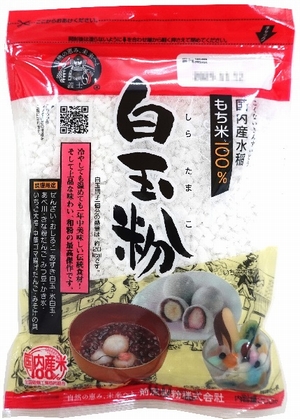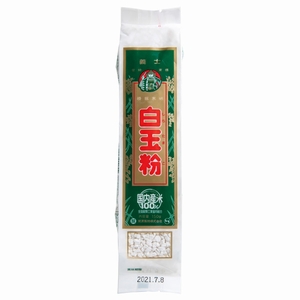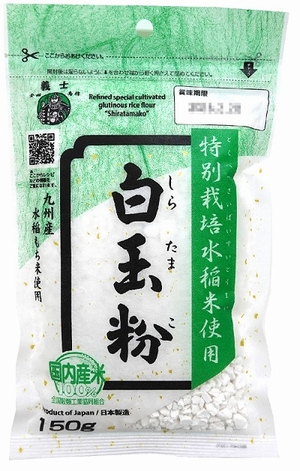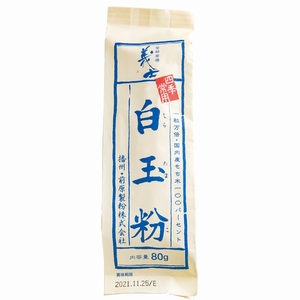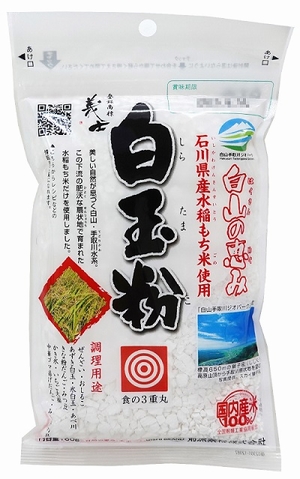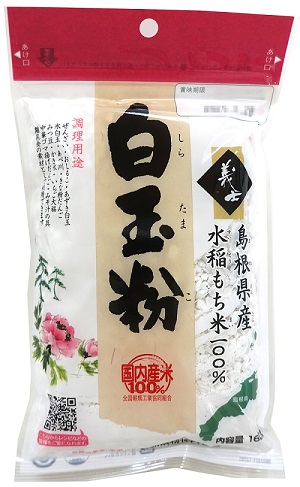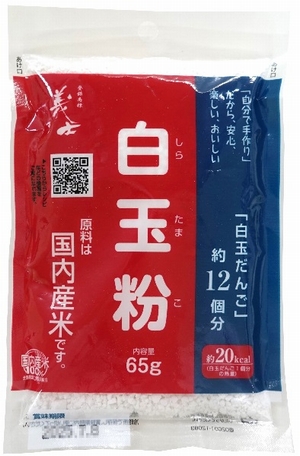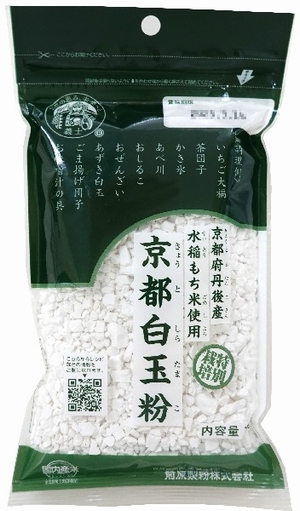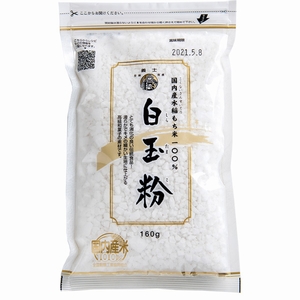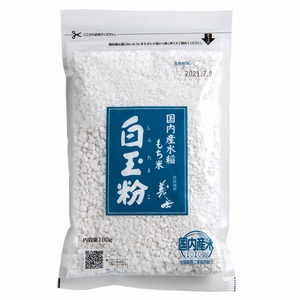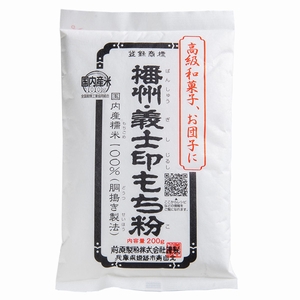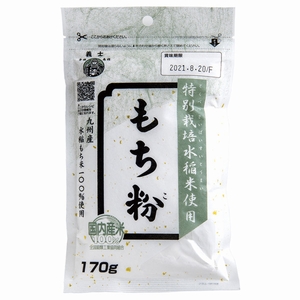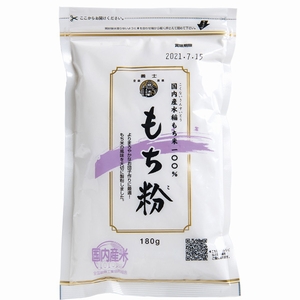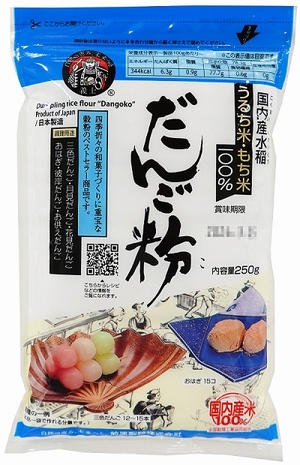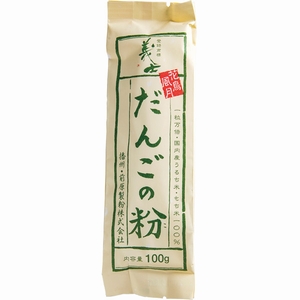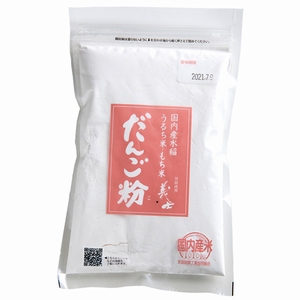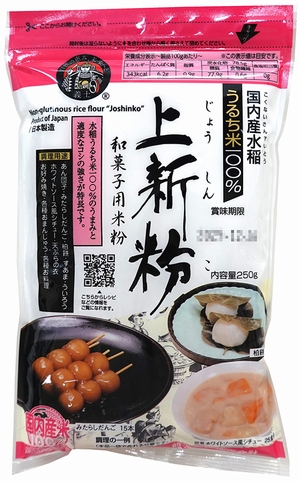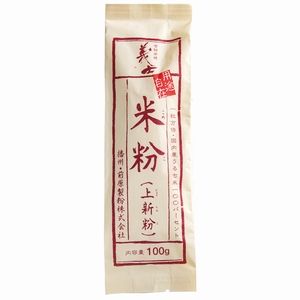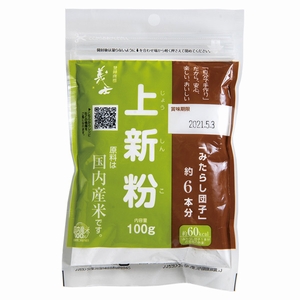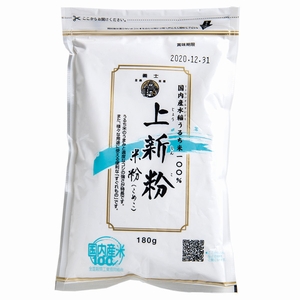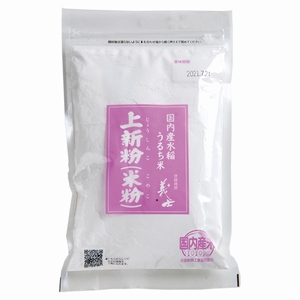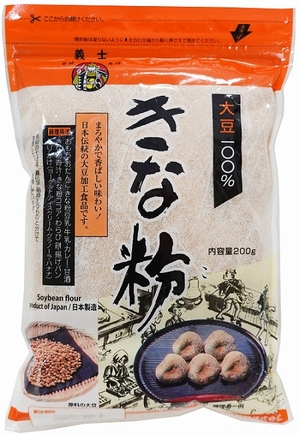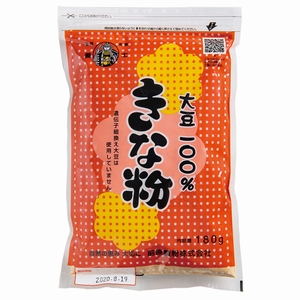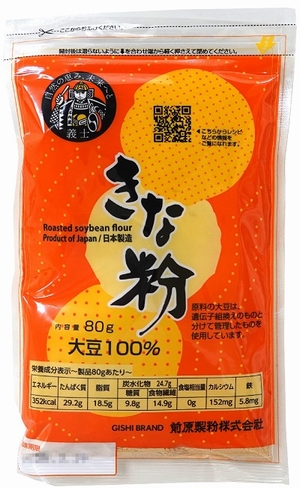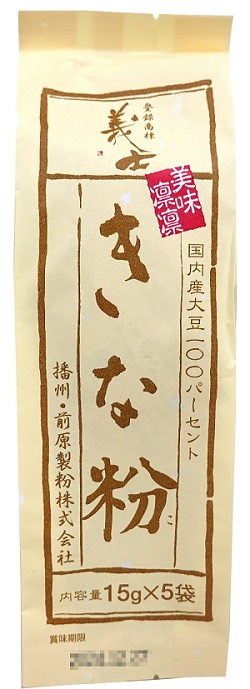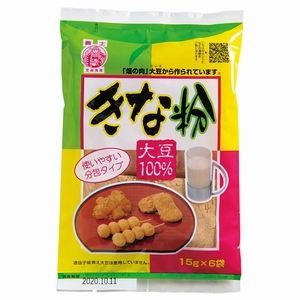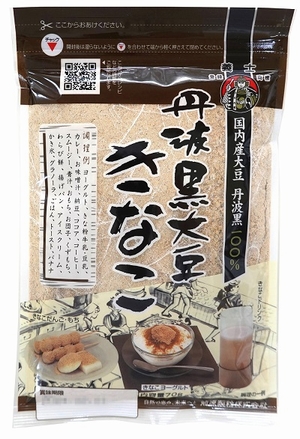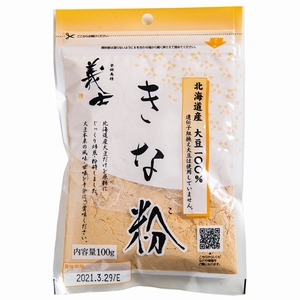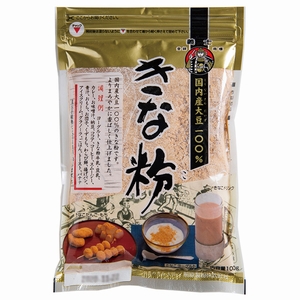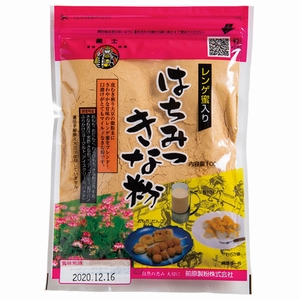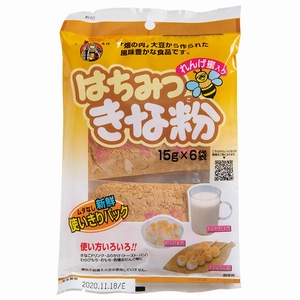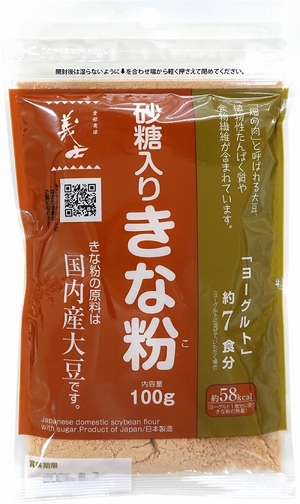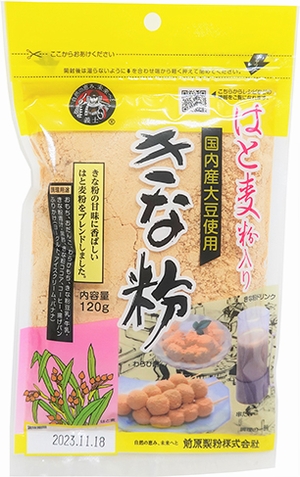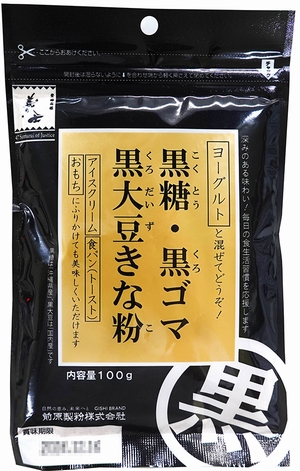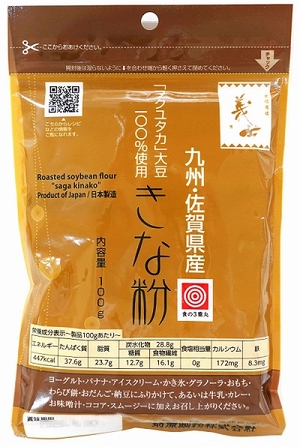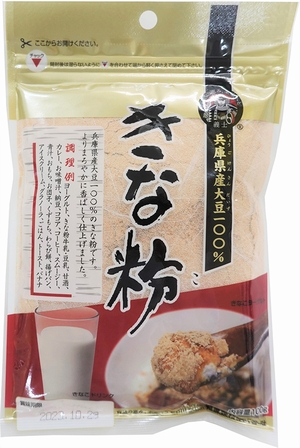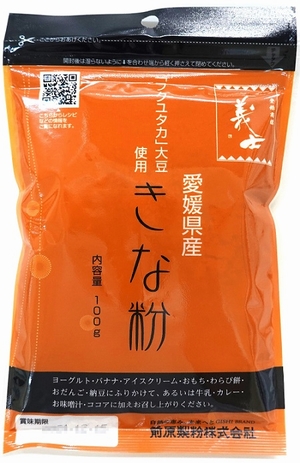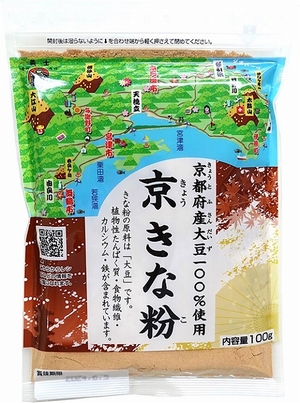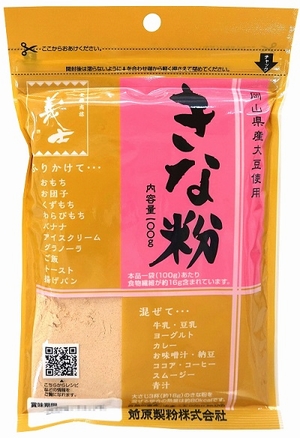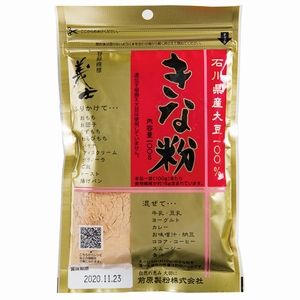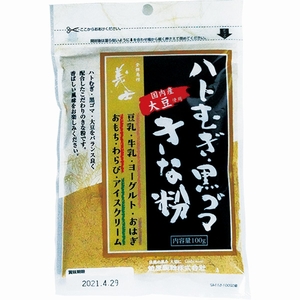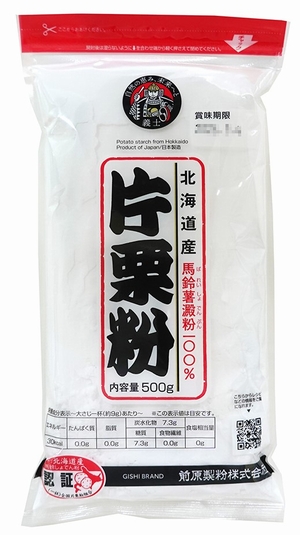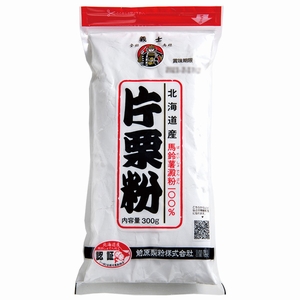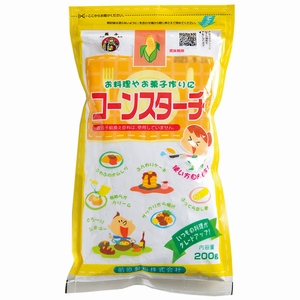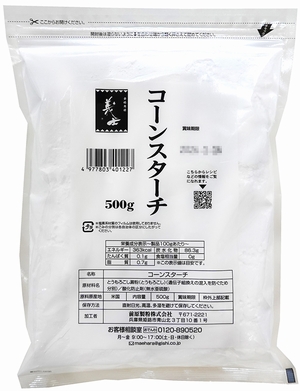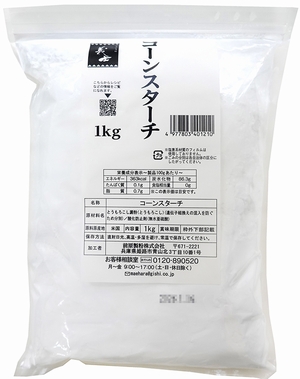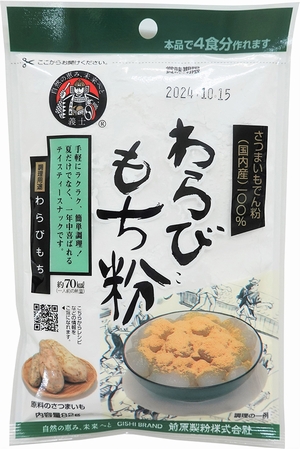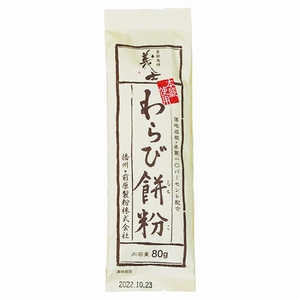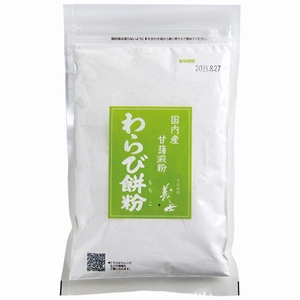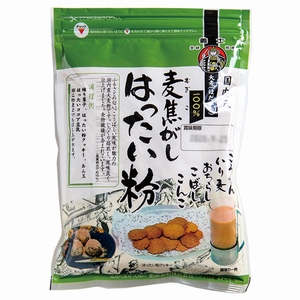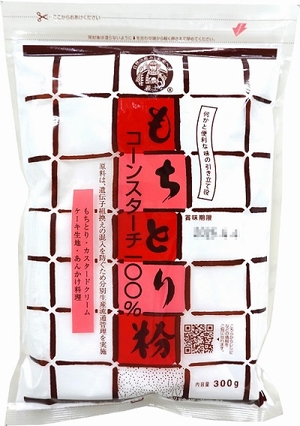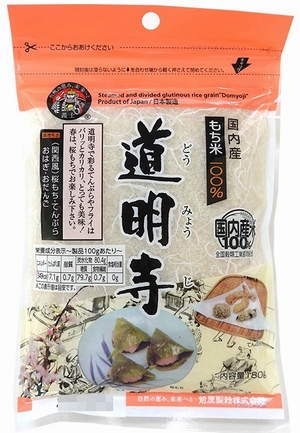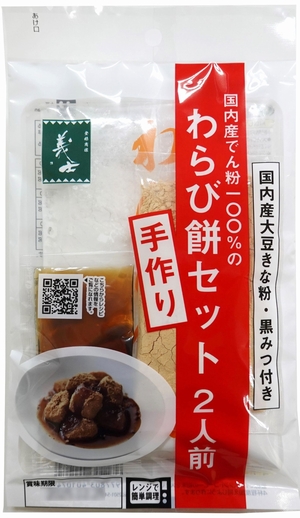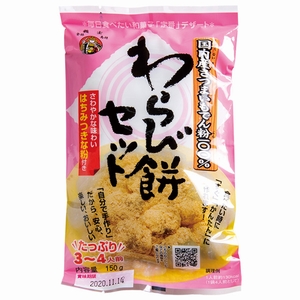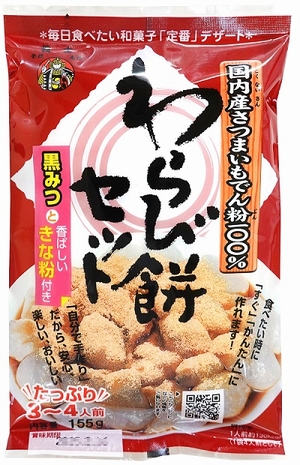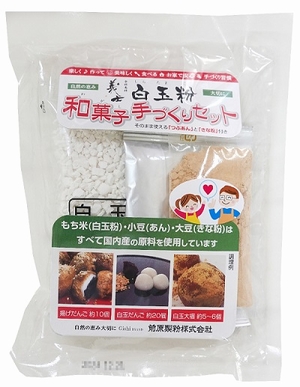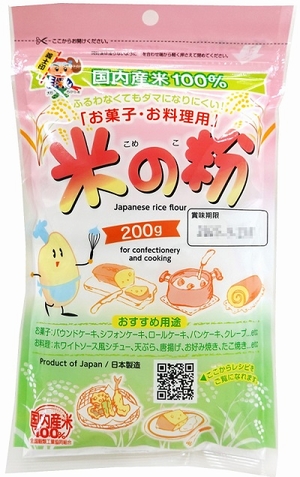商品案内和粉
白玉粉
寒ざらし粉とも呼ばれていて、もち白米を原料としています。昔は冬の寒さがきびしいころに、清潔な流水の得られるところで製造していましたが、現在は一年中製造されています。もち米を精白し、水に漬けて柔らかくして、水ごとすりつぶします。その白い液を圧縮脱水し、大きなかたまりにします。そのかたまりを細かく削り、乾燥して製造しています。良質なものは、乾燥が完全で、白色で光沢があり、粉質が微細です。ゆであげてフワッとした柔らかさと弾力があり、冷やしても固くならない品が、良品とされています。おもちとは別なまろやかな風味があり、白玉だんごやぎゅうひとして高級菓子材料になります。
Rice flour "Shiratama ko"
Rice flour, also called "Kanzarashi," is made of glutinous rice.
In the old times it was produced in the depths of winter where people can get running water, but now we can manufacture the flour all year round.
First, we polish the glutinous rice, next, we put them into water until it becomes soft. Then we grind the glutinous rice together with water.
After that we de-water and compress it to make a white ball shape. The ball shape is made into smaller round shapes and dried. Rice flour with good quality should be white, shiny, completely dried and minute. When we boil the rice flour it becomes not only soft but also elastic.
The rice balls which don’t become hard when they are cooled after boiling are of good quality.
It has a smooth taste which is different from mochi, and it is typically used to wrap of sweets "gyūhi" and flour dumplings (shiratama dango), and are materials for high-quality Japanese sweets.
もち粉
もち米を精白し、水に漬けて粉砕し、乾燥して製造します。メーカーによってうるち米・でんぷんを入れる場合もあります。白玉粉と同じく歯ごたえがまろやかで粘りの強いおだんごになりますが、白玉粉より製造工程が少なく低コストなので、和菓子原材料として業務用を中心に根強い需要があります。
Glutinous rice flour "Mochi ko"
We polish glutinous rice, soak it into water, grind it, and dry it to make Glutinous rice flour.
Sometimes non-glutinous rice and starch are added. It is used for making dumplings and the dumplings are glutinous and smooth. It takes fewer steps to make glutinous rice flour when compared to the number of steps to make rice flour and it costs less. Therefore there is a huge demand for mochi flour as material for Japanese sweets especially by manufacturer.
だんご粉
うるち米・もち米を精白し、水に漬けて粉砕し乾燥して製造します。メーカーによってでんぷんを入れる場合もあります。またうるち米・もち米の配合比率は一定していませんが、うるち米の入った分だけ、白玉粉やもち粉に比べてコシの強いおだんごになります。柔らか過ぎないので、おだんごを作りやすいとも言えます。
Dumpling flour "Dango ko"
We polish non-glutinous rice and glutinous rice, soak them in water, break them into pieces and dehydrate to make Dango flour.
Sometimes starch is added. The ratio of non-glutinous rice and glutinous rice combination is different. The more non-glutinous rice is added, the chewier becomes dumplings when compared to dumplings made with rice flour or mochi flour. Because Dumpling flour is not too soft, it is easy to make dumplings with it.
上新粉
うるち米を精白し、水に漬けて粉砕し、乾燥して製造します。もち米が入らないので、粘りやまろやかさよりも歯ごたえの強さを活かしたおだんごに向いています。家庭用としてはみたらしだんごや柏餅に最適ですが、業務用としては各種和菓子原材料として需要があり、米穀粉の中では最も多く生産されています。
Non-glutinous rice flour "Joshin ko"
We polish non-glutinous rice, soak them in water, break them into pieces and dehydrate them to make Non-glutinous rice flour. Because we do not use glutinous rice to make this flour, it is more suitable for making chewy dumpling. In family it is used for making "mitarashi", dumplings on a skewer with soy sauce and sugar and "kashiwamochi", a dumpling with bean jam inside wrapped in an oak leaf.
Manufacturers use non-glutinous rice flour as material for Japanese sweets and this flour is the most produced kind of rice flour.
きな粉
大豆を煎って粉末にしたものです。粗砕きした段階で皮を除き、更に粉砕しますが、皮を除かないものもあります。普通、黄大豆を用い黄褐色を呈しますが、青大豆を用いたものは「青きな粉」「うぐいすきな粉」と言い、淡緑色で香りも多少異なります。和菓子の製菓原料に用いるほか、餅につけてあべかわ餅にしたりします。でんぷん・たんぱく質・脂肪を含む栄養豊富な食品です。大豆のたんぱく質は良質ですが消化が悪いため、加工によってその欠点を補いますが、きな粉のように粉にしたものは炊豆・煮豆などに比べてかなり消化がよいと言われています。
Soybean flour "kinako" / Green soybean flour "aokinako"
This flour is made of roasted soybeans. First we break the beans roughly and peel them. Then we grind them into pieces. There is also a kind of the flour that we make without peeling the beans. Usually yellow soybeans are used to make soybean flour, but the flour made of blue soybeans is called Green soybean flour "aokinako" or Bush warbler soybean flour "uguisukinako". The color is pale green and the scent of the flour is different from the yellow one. We use soybean flour for making Japanese sweets and making "abekawa mochi", a rice cake dusted with soybean flour. The flour contains starch, protein and fat and therefore is nourishing. The proteins in soybeans is certainly good in quality but hard to digest.
This problem is solved by processing soybeans, and powdered one such as soybean flour is more digestible than roasted soybeans and boiled soybeans.
片栗粉
馬鈴薯でんぷん・じゃがいもからとったでんぷんで製造されています。現在片栗粉と呼ばれているものは、ほとんどが馬鈴薯でんぷんが原料です。また、ほとんどが北海道で製造されています。やはり、食用工業用原料として、ちくわ・かまぼこなど水産ねり製品や水あめなどに利用される他、家庭用ではあんかけやつなぎなどに消費されます。
Potato starch "Katakuri ko"
It is starch from potatoes. Almost all the potato starch is made from "Bareisho" potato in Hokkaidō prefecture. It is also famous as material in food industries and used for starch syrup and processed marine product such as a tubular roll of boiled fish paste "chikuwa", and a boiled fish paste "kamaboko". Potato starch is also used domestically to make starchy sauce for food and a thickener for food.
本葛
葛の根から取ったでんぷんが原料です。でんぷんの中では、最も良質とされていまして、奈良県の吉野葛、福岡県の筑前葛などのように産地名をつけて売られる事が多いです。ただ、「葛粉」という名前の商品でも、中身が葛ではないものも多く出まわっておりまして、まぎらわしいのが現状です。本葛は、コストも高いですが高級和菓子原料や、漢方薬として人気があります。
Arrowroot starch "Honkudzu ko"
It is starch from arrowroot (kudzu). This has the highest quality among all kinds of starch. It is usually sold with the name of the producing area.
For example, there are Yoshino-kudzu from Nara prefecture and Chikuzen-kudzu from Fukuoka prefecture.
However, there are products with the name "Kudzu flour" even though it is not made of arrowroot starch which confuses consumers.
Arrowroot starch is costly, but it is popular as material for Japanese sweets with high quality and as the material for a herb medicine.
コーンスターチ
とうもろこしの種子からとったでんぷんをコーンスターチといい、もちとうもろこしのそれは、ワキシースターチといいます。種子を亜硫酸水に浸し、粉砕して胚芽を分離したものを粉砕し、沈殿させたでんぷんを脱水・乾燥して製品にします。でんぷん類の中でも純度が高く、純白で無臭であり、粒子も細かい。従って食品工業用原料として幅広く使われています。家庭用では、片栗粉などと同じ用途で使われる事が多いです。
Corn starch
Corn starch is the starch from the corn seed, and the starch from sweet corn is called waxy starch. We soak the seeds in sulfur water, grind them, remove embryos and then grind them again into pieces. Then we dehydrate and dry settled starch to make this starch. This starch has high purity and is pure white and odorless. The grains of this kind of starch are very fine. Therefore it is used as material in food industries. Domestically the use is almost the same as potato starch.
わらび餅粉
さつまいもからとったでんぷんが原料です。鹿児島、宮崎など九州が主産地です。日本で最も多く生産されるでんぷんですが、その多くが食品工業用原料として、水あめ・ブドウ糖・のり・食用加工品・飼料・アルコールの原料に使われます。わらび餅は、主に西日本で夏には欠かせないおやつの一つです。
Bracken-starch dumpling flour "Warabimochi ko"
It is starch of sweet potato. Kyūshū area is the production center and it is produced especially in Kagoshima and Miyazaki prefecture. This is the most produced starch in Japan and most of this starch is used as material in food industries. Industries use bracken starch for making starch syrup, glucose (grape sugar), paste, edible processed goods, feed and alcohol.
Bracken-starch dumpling (warabimochi) is beloved summer sweets especially in Western Japan.
そば粉
はったい粉
原料は関東では大麦、関西以西では裸麦を使用します。また地方によってはトウモロコシやキビなどを原料とするところもあります。いずれも原料を煎ってこがし粉にしたもの。砂糖を混ぜてそのまま食べ、また湯で練って食べることもあります。麦落雁などの菓子の材料にもなり、関東では群馬県館林の名物となっています。関西では、はったい粉と呼びますが、こがし・いりむぎ・むがいりこ・麦こうせん・おちらしなどの別名もあります。かつては、暑気払いの飲み物や素朴な茶菓子・間食として人気がありました。
Burned barley/rye flour "Hattai ko / mugikogashi"
We make this flour in eastern Japan with barley and in western Japan with rye. In some areas, they use corn or millet to make this flour.
We parch the material and burn it to make this flour. We usually eat this flour with sugar as it is, or we can knead it with hot water to eat them sometimes.
This burned flour is also used to make a hard and dainty sweet mixed with sugar (mugirakugan) and this sweet is a specialty in Tatebayashi city in Gunma prefecture, eastern Japan. In western japan this kind of flour is called "hattaiko," but there are many other names such as "kogashi", "irimugi", "mugairiko", "mugikousen" and "ochirashi." It was popular as drink and simple teacakes and snack in summer to forget the summer heat.
もちとり粉
手粉ともいい、もちつきの時、もちが手や板につかないようにする為に使用します。通常は上新粉、片栗粉、あるいはコーンスターチなどを利用します。
Flour used for pounding steamed rice "Mochitori ko"
It is also called "Tekona." We use usually Non-glutinous rice flour (Joshinko), potato starch or corn starch when we pound steamed rice to prevent the rice cake stick to hand or to the plate.
かしわ餅粉
5月5日端午の節句用として、消費者向けに季節的に製造します。メーカーによっては中身が上新粉のままのものもあれば、上新粉に片栗粉などのでんぷんを入れたものもあります。でんぷんを少し混ぜるのは、おだんごにした時に歯切れが良くなり、柏の葉にくっつきにくくなる為です。
Flour for Kashiwamochi "Kashiwamochi ko"
We make this product only in certain season around the Boys’ Festival, 5th of May, for consumers who make Kashiwa dumpling, a dumpling which contains bean jam and is wrapped in an oak(Kashiwa) leaf. According to manufacturer, they sometimes put only non-glutinous rice flour (Joshin flour), or they sometimes mix starch such as potato starch into it. The reason of adding starch is because it makes the dumpling crispier so that it does not stick to the oak leaf, which wraps Kashiwa dumpling.
浮き粉
小麦でんぷんを精製した粉状のものを浮き粉、または本浮き粉といいます。また甘藷でんぷんで代用したものも浮き粉として市場に出ていることもあります。まんじゅうの皮やギョーザの皮、卵焼きやたこ焼きをふっくらと仕上げる増量剤として使われます。
Refined wheat starch flour "Uki ko"
We call refined wheat starch flour "Ukiko" or "Hon ukiko." Sometimes sweet potato starch is substituted for refined wheat starch. It is used for making thin wrapping steamed bean-jam bun and wrapping of gyōza. It is also used when we make omelet and takoyaki because this flour makes them fluffy.
道明寺
もち米を蒸して乾燥し、あらくひいた道明寺糒(ほしいい)を粉末にしたものです。ほとんどが桜もち・椿もちのなとでの菓子材料として用いられています。道明寺とは、大阪府藤井寺市にあるお寺の名前です。昔この寺で、天満宮に供えた饌飯の下がりを信者に与えたところ大変評判になったため、あらかじめ飯を乾燥貯蔵するようになったのが始まりとされています。
Dōmyōji flour
We steam glutinous rice, dry and grind to make Dōmyōji dried cooked rice. Then we break it into pieces to make Dōmyōji flour. It is mostly used as material for Sakura mochi and Tsubaki mochi.
Dōmyōji is a temple in Fujīdera-city in Osaka prefecture. Once in Dōmyōji temple they provided an offering removed from the altar and the offering is beloved by people. Therefore the temple has started to keep the dried cooked rice previously. This story is said to be the beginning of this flour.



